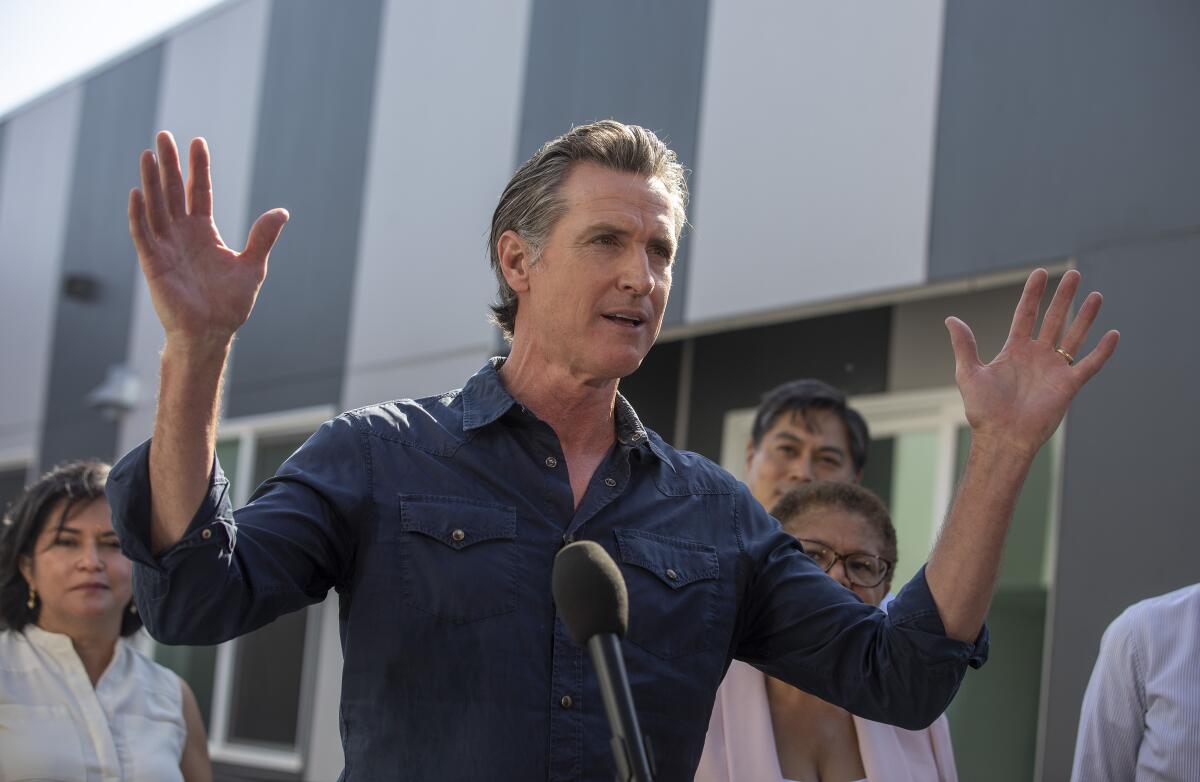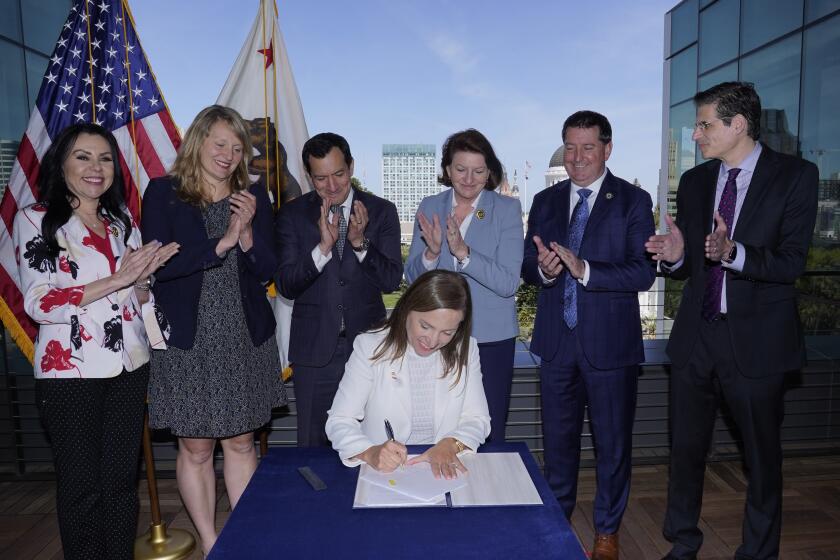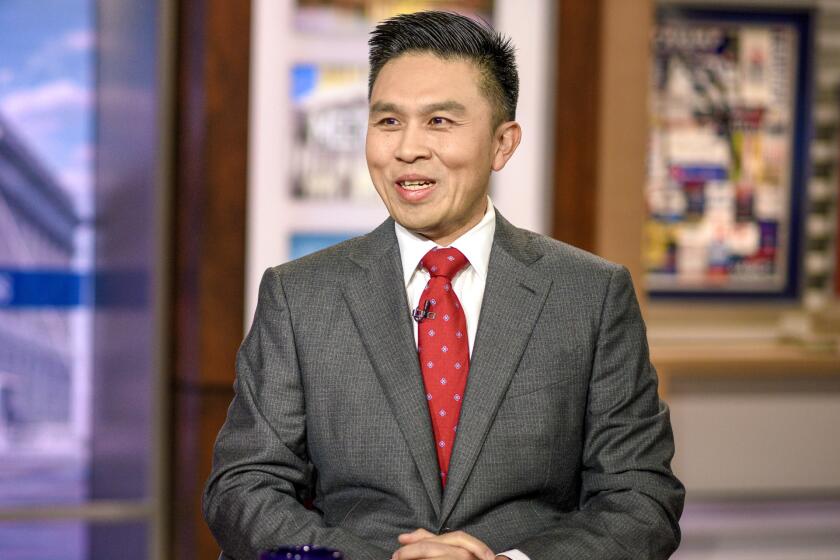Endorsement: Gov. Newsom has earned another term leading California

In responding to a series of events largely beyond his control, Gov. Gavin Newsom has emerged as one of the most powerful governors in California history.
President Biden’s election allowed Newsom to reshape Democratic leadership in the state with a series of historic appointments. He named Alex Padilla as California’s first Latino U.S. senator when Kamala Harris stepped down to become vice president; Shirley Weber as the state’s first Black secretary of state to replace Padilla; and Rob Bonta as the first Filipino American California attorney general when Xavier Becerra resigned to join Biden’s Cabinet. Not since the 1950s had a governor named so many people to such heights of power in just a few weeks’ time — and certainly not with such a focus on diversity.
When the COVID-19 pandemic hit in 2020, Newsom gained extraordinary power to manage the disaster with a statewide emergency order that is still in place today. It gives him broad authority to change regulations, suspend laws and redirect money, power upheld by the state Supreme Court after it was challenged in a lawsuit filed by two Republican lawmakers. Newsom has largely wielded the power responsibly, though most classrooms were shuttered for too long last year and we wish he’d required school districts to get students back on campus sooner.
Backlash against Newsom’s pandemic response led to the 2021 recall election, but Newsom emerged even stronger. He crushed the attempt to throw him out of office with support from 62% of voters and coasted into this reelection year. It’s clear that Newsom is working not just to retain power, but to put it to good use by passing progressive policies in California and launching himself into national politics as a spirited voice on the left.
The L.A. Times’ editorial board endorsements for statewide ballot measures, elected offices in Los Angeles city and county, L.A. Unified School District board, L.A. county superior court, statewide offices, the state Legislature and U.S. House and Senate seats.
Newsom has launched TV commercials in Florida, full-page newspaper ads in Texas and billboards in several other red states to pitch California as the place for freedom while jabbing conservative states that are yanking away abortion rights. It’s an unconventional reelection campaign strategy that reflects Newsom’s uncommonly secure position. Republicans blew what little political currency they have in this blue state on the foolish recall attempt last year, leaving no campaign infrastructure to mount a robust opposition to Newsom this time around.
His opponent on the Nov. 8 ballot is GOP state Sen. Brian Dahle, who represents a rural district in the northeast corner of the state. Dahle is a respected legislator who has made unusual strides to collaborate with Democrats during his decade in the state Capitol. He has a long resume of public service and is more prepared to govern California than most candidates on the recall ballot last year.
But Dahle’s positions on key issues put him out of step with most California voters. He opposes abortion and voted against placing Proposition 1 on the ballot to give voters the chance to enshrine the right to abortion and contraception in the California Constitution. He’s voted against numerous gun safety bills. He twice supported Donald Trump for president and, until he won the primary this year, refused to denounce Trump’s “Big Lie” that Biden’s election was fraudulent.
Newsom, meanwhile, is using his elevated power to great effect in Sacramento. This year he pushed the Legislature to pass an ambitious set of bills to curb climate change, including ideas that have surfaced year after year but never garnered enough support to pass — even in a Capitol dominated by Democrats. The governor’s leadership was essential to get enough lawmakers on board to pass legislation banning new oil and gas drilling near homes and schools, requiring greater reductions of greenhouse gas emissions by 2030 and achieving carbon neutrality by 2045.
Eleni Kounalakis has grown into the role and inspires the kind of confidence you want in the gubernatorial understudy.
Amid a horrendous wave of mass shootings, Newsom threw his support behind gun safety legislation. Following the U.S. Supreme Court’s terrible decision to overturn Roe vs. Wade, he signed numerous bills to expand access to abortion and prepare California for an influx of pregnant people from out of state seeking reproductive healthcare. And in a tacit acknowledgment that too many working Californians live in poverty, Newsom approved new laws that could raise wages for fast-food workers, make it easier for farmworkers to form unions and allow more low-income workers to take paid family leave.
He also pushed through a controversial plan to create a new court system to compel treatment for people who are severely mentally ill or addicted to drugs, an attempt to address the human misery obvious in the encampments proliferating on so many California streets and riverbanks and in freeway underpasses. We didn’t support this plan, but now that it’s law Newsom must ensure that it’s carried out effectively by providing sufficient funding for treatment.
It was a successful year of lawmaking that capped an already bold set of changes Newsom put in place earlier in his term. He’s approved plans to provide preschool to all 4-year-olds by 2025 and health insurance to all low-income residents regardless of immigration status by 2024. He’s committed to closing two prisons and phasing out the sale of new gas-powered cars.
He’s a political outsider with the independence to examine why state spending has not yielded better results.
All of this leads us to reiterate our endorsement in the primary. Newsom has been a solid leader during an extraordinarily difficult time in the state’s and nation’s history. His legacy will be determined by whether he can do more than sign bills and walk away. He must spend his next term ensuring that his progressive vision for California becomes reality. It will not be easy, but as Newsom has said many times, “Program passing is not problem solving.”
One problem Newsom needs to solve in his next term is the fallout from California’s legalization of cannabis. He led the legalization campaign in 2016 that promised to create a controlled market accessible only to adults, reduce the environmental harm of illegal pot farms, curb the power of criminal drug gangs and help repair damage from the racist war on drugs. But a Times investigation shows that many of those promises have been broken. Illegal pot grow operations have proliferated, often with workers facing violence and squalid conditions. The competition to enter the legal marijuana marketplace has led to a rash of corruption in local governments. Drug dealers who operate illegal dispensaries are almost never prosecuted. Cannabis legalization in California is an absolute mess.
Newsom has spent four years approving groundbreaking changes that have great potential to make life better in this state. He deserves a second term to allow him to effectively carry out his vision.
More to Read
A cure for the common opinion
Get thought-provoking perspectives with our weekly newsletter.
You may occasionally receive promotional content from the Los Angeles Times.













